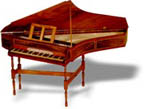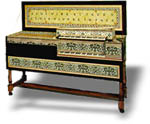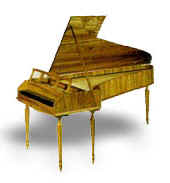We offer a Spinet kit and three Virginals
kits:
English Bentside Spinet Kit
 Our
Bentside Spinet Kit supplies all of the items to make a handsome replica of a 1765 Baker
Harris instrument. We have followed the details of the original with extreme care. By
patiently assembling the materials and paying close attention to the drawings,
instructions and photographs, the kit builder should be able to make a nearly perfect copy
of the Baker Harris spinet. Our
Bentside Spinet Kit supplies all of the items to make a handsome replica of a 1765 Baker
Harris instrument. We have followed the details of the original with extreme care. By
patiently assembling the materials and paying close attention to the drawings,
instructions and photographs, the kit builder should be able to make a nearly perfect copy
of the Baker Harris spinet.
Eighteenth century English harpsichords in general were more often
veneered than painted. Veneers supplied with the Bentside Spinet Kit enable the maker to
reproduce the Baker Harris classic decor of figured walnut panels on the case and in the
keyboard well, outlined with degamé stringing and mahogany crossbanding. Walnut veneer is
supplied for the inside edge of the case, the jack rail and the name batten. The lid,
trestle stand, music desk and other smaller parts, including moldings for the case and lid
are provided in solid mahogany. The keyboard supplied with this kit has dark hardwood
sharps and light colored degamé naturals. A bone-covered keyboard is available as an
option. Reproductions of Baker Harris solid brass strap hinges for the lid, and butterfly
hinges for joining the keyboard cover to the lid are available at additional cost.
Phosphor bronze music wire is offered to those builders who wish to tune their spinets to
A-440 instead of A-415.
Listen
to the English Bentside Spinet kit...
We
now have a demonstration CD of this instrument available ($10.00 ppd.
in U.S.). Please - inquire via our contact
form.
Download
a Bentside Spinet Description and Price Guide

Flemish
Single- & Double-Manual Virginals Kits:
"Mother & Child"
 Flemish
virginals emerged in the 17th century as two distinct instruments depending
on which side of the front of the instrument the keyboard was located.
Those with the keyboard positioned to the right were known as muselars
and produced a round, fluty sound of unusual power. The spinet
whose keyboard lies to the left of the center produces a sound approaching
that of the wing-shaped harpsichord of the period. The ottavino
or "Child" virginals lives in the body of the "Mother"
and is pitched one octave higher than either the spinet or the
muselar virginals. When played, it is pulled forward like a drawer
in a bureau, or removed completely and placed on top of the eight-foot
virginals cleverly forming a second keyboard at four-foot pitch. Flemish
virginals emerged in the 17th century as two distinct instruments depending
on which side of the front of the instrument the keyboard was located.
Those with the keyboard positioned to the right were known as muselars
and produced a round, fluty sound of unusual power. The spinet
whose keyboard lies to the left of the center produces a sound approaching
that of the wing-shaped harpsichord of the period. The ottavino
or "Child" virginals lives in the body of the "Mother"
and is pitched one octave higher than either the spinet or the
muselar virginals. When played, it is pulled forward like a drawer
in a bureau, or removed completely and placed on top of the eight-foot
virginals cleverly forming a second keyboard at four-foot pitch.
How
the "Mother & Child" work: In the large virginals
a single set of strings runs the length of the instrument which is normally
positioned in the room against a wall. The key levers run underneath
the soundboard from front to back increasing in length as they progress
from bass to treble. This allows them to have about the same mechanical
advantage in lifting the jacks throughout the compass of the instrument.
The key levers are guided vertically at the back with a rack and overrail
to limit the amount of key dip. The balance mortises are also made in
the manner of the old makers by punching directly into the key lever.
The keys lift the jacks which rise through a leather covered register
set into the soundboard. The jacks face alternately toward and away
from the player making it possible for the strings to fit into half
the space they would normally occupy in a harpsichord.
The
action and lay-out of the diminutive ottavino are similar to
the large instrument. The salient feature of the ottavino is
its extreme compactness. In order to couple the ottavino to its
motherthe jackrail of the large virginals is removed and the ottavino
set in its place. When played from the lower keyboard, the jacks of
the large virginals then perform double duty by both plucking the eight-foot
strings and raising the ottavino keys through a slot cut in the
bottom of the smaller instrument. This provides the player with a 1
x 8', 1 x 4' disposition. One would be hard put to use a half-pint of
paint on the ottavino.
Both
spinet and muselar kits are designed with the ottavino in mind.
Any Hubbard ottavino will fit any Hubbard muselar or spinet
virginasl. It is, of course, possible to build the large virginal
first and add the ottavino later, or vice-versa. The range is C-c''',
49 notes. Both spinet and muselar are disposed 1 x 8', the ottavino
is disposed 1 x 4'.
With our large virginals kits we include a trestle stand in oak with
four turned legs. A 17th century oak joint stool kit is available
that nicely complements the stand.
Listen
to the Flemish virginals kits...
We
now have a demonstration CD of this instrument
available ($10.00 ppd. in U.S.). Please - inquire via our
contact form.
Download a Flemish Virginals
Description and Price Guide

Viennese
18th Century Fortepiano Kit
This
design has been retired as a kit for an indefinite term
 Our
fortepiano kit is a replica of a Stein instrument of 1784 and closely reproduces the tone
and action as well as the details of construction of this early piano. It has a range of
five octaves, FF-f''' and is double-strung throughout except for the top 14 notes which
are triple-strung. The strings are low tensile steel from the tenor through the treble
ranges, and brass in the bass. The keyboard has a 6 1/4" octave span, a short (1
3/8") key front, and low, narrow sharps. The key levers are unbushed and guided at
the rear of the keyboard. The naturals are covered with ebony and the sharps with bone. Our
fortepiano kit is a replica of a Stein instrument of 1784 and closely reproduces the tone
and action as well as the details of construction of this early piano. It has a range of
five octaves, FF-f''' and is double-strung throughout except for the top 14 notes which
are triple-strung. The strings are low tensile steel from the tenor through the treble
ranges, and brass in the bass. The keyboard has a 6 1/4" octave span, a short (1
3/8") key front, and low, narrow sharps. The key levers are unbushed and guided at
the rear of the keyboard. The naturals are covered with ebony and the sharps with bone.
I wish to thank you for your interest in the Viennese fortepiano kit. I regret to announce that, after 30 years of its availability, I have become convinced of our need to retire this instrument from production. It is a very simple matter. The amount of activity for this design recently has dwindled to the point where it is no longer particularly profitable to produce and yet keep affordable. In contrast to our harpsichord kit offerings, it demands both a different stock of wood, material and parts (much of which must be stored ahead, some at the risk of spoilage), as well as a markedly different skill set. Consequently the difficulty in scheduling work and producing a satisfactory product has passed my tipping point and I have reluctantly made the decision to terminate the Viennese Fortepiano kit's availability. I would prefer we do things well rather than otherwise. We will, of course, continue to support and repair existing kits and finished instruments. If enough demand becomes apparent I may decide, as a compromise, to schedule a fortepiano kit run every several years or as orders accumulate. If you wish to inquire further about the fortepiano kit or explore possibilities, please feel free to contact me at finfo@hubharp.com.
Hendrik Broekman
This
design has been retired as a kit for an indefinite term. 
|